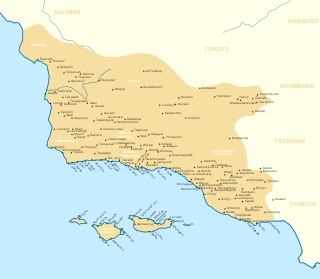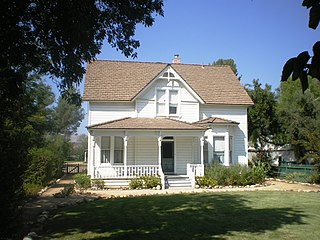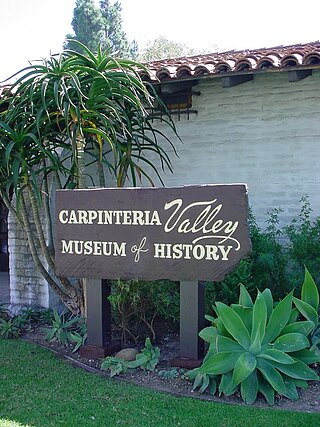
Mission La Purísima Concepción, or La Purísima Mission is a Spanish mission in Lompoc, California. It was established on December 8, 1787 by the Franciscan order. The original mission complex south of Lompoc was destroyed by an earthquake in 1812, and the mission was rebuilt at its present site a few miles to the northeast.

Santa Barbara County, officially the County of Santa Barbara, is located in Southern California. As of the 2020 census, the population was 448,229. The county seat is Santa Barbara, and the largest city is Santa Maria.

The Chumash are a Native American people of the central and southern coastal regions of California, in portions of what is now Kern, San Luis Obispo, Santa Barbara, Ventura and Los Angeles counties, extending from Morro Bay in the north to Malibu in the south to Mt Pinos in the east. Their territory includes three of the Channel Islands: Santa Cruz, Santa Rosa, and San Miguel; the smaller island of Anacapa was likely inhabited seasonally due to the lack of a consistent water source.

Lompoc is a city in Santa Barbara County, California, United States. Located on the Central Coast, Lompoc has a population of 43,834 as of July 2021.

The Florida Museum of Natural History (FLMNH) is Florida's official state-sponsored and chartered natural history museum. Its main facilities are located at 3215 Hull Road on the campus of the University of Florida in Gainesville.
Newbury Park is a populated place and town in Ventura County, California, United States. Most of it lies within the western Thousand Oaks city limits, while unincorporated areas include Casa Conejo and Ventu Park. The town is located in Southern California around 8 miles (13 km) from the Pacific Ocean and has a mild year-round climate, scenic mountains, and environmental preservation. About 28,000 residents of Thousand Oaks reside in Newbury Park.

The Stagecoach Inn Museum in Newbury Park, California, originally known as the Grand Union Hotel, was used as a resting area for people who traveled from Los Angeles to Santa Barbara. Besides a hotel and stagecoach stop, it has also been used as a post office, church, restaurant and military school. It is California Historical Landmark No. 659 and is listed in the National Register of Historic Places. It played a major role in the development of the stage line transportation network in California. The hotel was also the first business venture in the Conejo Valley.

The Neanderthal Museum is a museum in Mettmann, Germany. It was established in 1996. Located at the site of the first Neanderthal man discovery in the Neandertal, it features an exhibit centered on human evolution. The museum was constructed in 1996 to a design by the architects Zamp Kelp, Julius Krauss and Arno Brandlhuber and draws about 170,000 visitors per year. The museum also includes an archaeological park on the original discovery site, a Stone Age workshop, as well as an art trail named "human traces". All signs in the museum as well as the audio guide offered by the museum are available in German and English.

The historic Simi Adobe–Strathearn House served as the headquarters of Rancho Simi, also known as Rancho San José de Nuestra Senora de Altagracia y Simi, one of the land grants in Alta California by the Spanish government. The name derives from Shimiji, the name of the Chumash village here before the Spanish. Rancho Simi was the earliest Spanish colonial land grant within Ventura and Santa Barbara Counties. At 113,000 acres, Rancho Simi was one of the state's largest land grants.

The Burro Flats site is a painted cave site located near Burro Flats, in the Simi Hills of eastern Ventura County, California, United States. The Chumash-style "main panel" and the surrounding 25-acres were listed on the National Register of Historic Places in 1976, with a boundary decrease in 2020. The main panel includes dozens of pictographs in a variety of colors. The cave is in the mountains, near the bi-lingual Chumash/Fernandeno village of Huwam/Jucjauynga. The Burro Flats painted cave and the rest of the former Santa Susana Field Laboratory are not accessible to the public.

The Western Science Center (WSC), formerly the Western Center for Archaeology & Paleontology, is a museum located near Diamond Valley Lake in Hemet, California. The WSC is home to a large collection of Native American artifacts and Ice Age fossils that were unearthed at Diamond Valley Lake, including "Max", the largest mastodon found in the western United States, and "Xena", a Columbian mammoth, as well as dinosaur fossils recovered from New Mexico.

The Carpinteria Valley Museum of History (CVMH) is a museum located in Carpinteria, California. It is operated by the non-profit Carpinteria Valley Historical Society primarily through membership dues, memorial donations, endowment income, and fund-raising activities. The museum is staffed by volunteer docents.

The Sisquoc Formation is a sedimentary geologic unit widespread in Southern California, both on the coast and in mountains near the coast. Overlying the Monterey Formation, it is of upper Miocene and lower Pliocene age. The formation consists of claystone, mudstone, siltstone, shale, diatomite, and conglomerates, with considerable regional variation, and was deposited in a moderately deep marine environment at a depth of approximately 500–5,000 feet (150–1,520 m). Since some of its diatomites, along with those of the underlying Monterey Formation, are of unusual purity and extent, they can be mined as diatomaceous earth. France-based Imerys operates a mine in the Sisquoc and Monterey Formations in the hills south of Lompoc, California, the largest such operation in the world.

Caddo Mounds State Historic Site (41CE19) is an archaeological site in Weeping Mary, Texas. This Caddoan Mississippian culture site is composed of a village and ceremonial center that features two earthwork platform mounds and one burial mound. Located on a precontact Native American trail later named by the Spanish as El Camino Real de los Tejas, the settlement developed hundreds of years before the arrival of Europeans to the region. Archaeologists believe the site was created in approximately 800 CE, with most major construction taking place between 1100 and 1300 CE.
The Dubois Museum is a 3,850-square-foot (358 m2) museum preserving and interpreting the history of the Upper Wind River Valley and is located in the town of Dubois, Wyoming on U.S. Route 26 along the Wyoming Centennial Scenic Byway. The museum offers interpretive programs, exhibits, multi-media presentations, and special events.
Satwiwa was a former Chumash village in the Santa Monica Mountains of Newbury Park, California. The current Satwiwa Native American Indian Culture Center is operated by the National Park Service in cooperation with the Friends of Satwiwa. Satwiwa has been inhabited by Chumash Indians for over 10,000 years. It is situated at the foothills of Boney Mountain, a sacred mountain for the Chumash.

Chumash Indian Museum is a Native American Interpretive Center in northeast Thousand Oaks, California. It is the site of a former Chumash village, known as Sap'wi. It is located in Oakbrook Regional Park, a 432-acre park which is home to a replica of a Chumash village and thousand year-old Chumash pictographs. The pictographs by nearby Birthing Cave are not open to the public, but can be observed on docent-led tours. Chumash people inhabited the village 10,000 years ago.

Ancient Echoes Interpretive Centre is a community-based museum and interpretive centre, founded in 1994, that educates, conserves, protects, and promotes the history, the peoples and the assets of the land forming the Eagle Creek Valley and Coal Mine Ravine located in Herschel, Saskatchewan, Canada.
The Hiwassee River Heritage Center is a history museum located in Charleston, Tennessee which was established in 2013. The museum chronicles the region's Cherokee and Civil War history. It is a certified interpretive center on the Trail of Tears National Historic Trail.
















